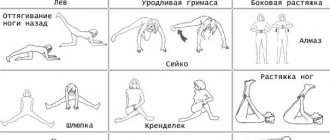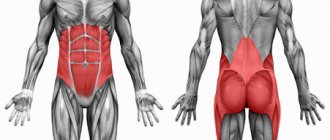Exercise 1. Making swings
It is a good exercise for the thighs and buttocks. Swinging your leg back with support on your hands will tighten your buttocks and tidy up the back of your thigh.
To perform swings, you need to get into the starting position on all fours. The toe should reach towards the ceiling, and it is important to tighten the gluteal muscles well. Raise and lower the leg, bent at the knee at a right angle. Do 15-30 repetitions on one side, then change it.
You should ensure that the stomach is pulled in and the lower back does not sag.
The Importance of Exercise
It is extremely important to help the body wake up. Physical exercise accelerates blood flow, raises general tone, and brings the nervous system into working condition. All together it charges with energy and adds strength. Light, enjoyable activities improve your mood.
And with a good attitude, starting the day is much easier.
Regular morning exercise also helps:
- Remove excess weight. Exercise normalizes digestion and metabolism. Constant moderate exercise burns fat and helps strengthen muscles. As a result, the body appears to be tightened, the figure becomes slimmer and stronger.
- Increase willpower. It won't be easy to get up early for your first exercise. But in a week or two the situation will change. It takes up to two months for the habit to become firmly established. Having overcome yourself here, you can safely begin to resolve issues in other areas of life.
- Improve the quality of mental activity and boost immunity. Exercise saturates the body with oxygen, which is good for the brain. He begins to work more productively. A trained body is better able to resist disease.
The main rule for beginners is that the morning exercise complex should not contain strength exercises. It is important to stretch the body, and not load it. Otherwise, all efforts may go down the drain.
Exercise 2. Lunges with a spring effect
Lunge forward so that the thigh of the front leg and the shin of the back leg are parallel to the floor. During the exercise, you need to pay attention to the following point: the kneecap on the front leg should not extend beyond the toe. From this position, perform 5 springy movements at an average pace.
It is recommended to perform 30 repetitions on one side, then change it. Exercise will help make your legs strong.
What results can you achieve in a 20-minute workout? - Om Activ
- Before starting intensive training, undergo a medical examination.
Simply, interval training is a workout during which the intensity of the load alternates in equal time intervals. Intensity is measured by heart rate. This is important because many people believe that the type of load alternates between strength training and cardio. So intervals can be strength, cardio or mixed. We wrote about it here.
- High-intensity interval training is an interval during which you alternate between high intensity and medium intensity, and less often, low intensity. That is, sometimes it’s difficult for you (your heart beats quickly), and sometimes it’s very difficult (your heart beats very quickly).
The duration of such training depends on the physical capabilities of the person - from 10 to 20 minutes. The classic method is training by master Izumi Tabata (more about him here), which involves intense work for 20 seconds and a 10-second rest. The cycle is designed for 4 minutes; in a 20-minute workout you have time to complete 3-5 cycles of exercises. In the beginning, try to just survive for 20 minutes. Then work your way down to 8 exercises per 4 minutes in a 20 minute workout.
- For HIIT, you can use any exercise that allows you to maintain the desired heart rate.
HIIT can be practiced 3 times a week as a main 20-minute workout, or as an addition to strength training. Depends on the goal - more on that below.
Goals
Yes: weight loss.
HIIT is ideal for burning fat due to the high speed of exercise, maximum oxygen consumption and the inclusion of both types of muscle fibers during training. With such explosive training, fat burning occurs not only during the workout, but also during the recovery period after it - the body spends a lot of calories to eliminate the consequences of the resulting stress.
How much: Add HIIT cardio to your main program. For example, if you train three times a week, continue training three times a week, but start each session with HIIT cardio.
Yes: general tone.
Alternate between strength training and HIIT cardio to keep your body in good shape.
How much: give preference to strength or mixed HIIT. Start or end a session with it, or you can add it as a separate workout on a rest day. Remember recovery!
Yes: slight relief
No: large muscle volume
Yes, you will become stronger. By combining HIIT with strength training (plus proper nutrition) you may gain 1-2 kg of muscle mass, but don’t expect serious weight gain. HIIT aims to improve high-speed performance, where catabolism (muscle breakdown) takes precedence over anabolism (muscle growth).
How much: If you don't have extra weight in the form of body fat, add one HIIT per month to your core strength training for variety. If you want to burn fat, add these workouts three times a week. Exercise for up to 30 minutes with intervals of 20/10 seconds for advanced, or 30/30 seconds for intermediate levels.
Yes: work on the problem area.
Here is an example of a workout focusing on the legs and buttocks. Please note that we are working on the problem area in a high intensity zone.
| Press | average |
| Squat | high |
| Shoulders | average |
| Stanovaya | high |
| Hands | average |
| Lunges | high |
You can also work only on the problem area, alternating intensity zones.
| Press | average |
| Press | high |
| Press | average |
Etc.
So, HIIT has both pros and cons, so you will make your own personal conclusion, depending on your level of training and training goal. Consider the following facts.
Yes: strengthens the cardiovascular system
The blood vessels are strengthened, the heart gets used to the heavy load. Explosive physical activity (lifting a heavy bag from the floor) in everyday life will no longer be stressful for him.
How much: 1-2 times a week in addition to basic training.
pros
- 1High intensity with short duration, saving time.
- 2Ability to train without a wide range of equipment.
- 3Inclusion of both fast and slow fibers, overall load on all muscle groups, appearance of relief.
- 4Possibility of local impact on problem areas.
- 5Cardiovascular system training.
- 6The opportunity to train in groups, which adds a competitive element and leads to positive results.
- 7A great way to quickly lose weight.
Minuses
- 1There are restrictions (initial level of training, limited capabilities, advanced age).
- 2The need to constantly monitor the pulse zone, distracting yourself from exercise. If you have monitors, the minus is not felt. We wrote about choosing monitors here.
- 3No serious muscle gain. The downside is not for everyone.
Remember! Choose intervals based on your physical fitness. Let the intervals prescribed in the article be only a guideline for you, do not try to achieve them right away and exhaust yourself.
What heart rate zone should you be during interval training?
Exercise 3. Diagonal lunge
Starting position: stand straight, feet shoulder-width apart. Then lunge back, keeping a diagonal. You should try to lower your shins until they are parallel to the floor. The thigh of the front leg should form a right angle with the shin. Return to the starting position and do all this with the other leg.
Lunges will make the shape of your buttocks attractive. This is the best exercise for the inner and back thighs, helping to lose weight in these areas. Do about 10-20 repetitions on each side.
Important! To achieve maximum benefits from exercise, you need to exercise regularly for 30-40 minutes a day.
Proper nutrition
20-minute exercises will not bring much benefit without a balanced diet of proteins, fats and carbohydrates. It is these components that “build” our muscles. Try to reduce your consumption of fast carbohydrates (flour, fast food, chocolate, etc.) and add slow carbohydrates (porridge, noodles, etc.) to your diet. This will allow you to achieve muscle tone in a short time.
Exercise 4. Deep lunge from a half squat
Take a half-squat position. It is important that your kneecaps do not extend beyond your toes. The right leg is pulled back and the entire body weight is transferred to it.
Then straighten it at the knee. Return to a half-squat and take your left leg back. The exercise is done alternately on each leg. The half-squat position is maintained throughout the entire time - this is the most important thing in this exercise.
To achieve a good effect, do about 10-15 times on each side.
Exercise 5. Swing forward
Stand straight, feet shoulder-width apart, spread your arms to the sides to create balance. The right leg rises up at an angle of 90 degrees, making a swing.
Then you need to try to hold it for a few seconds in this position. The body weight should be transferred to the supporting leg, balance is maintained throughout the entire time. You need to keep your back straight and not bend your knee.
Perform 10-20 repetitions on one leg.
What does science say?
A study conducted at the University of Utah shows that all those small intervals of exercise that a person does throughout the day can be very beneficial. In fact, even one brisk minute can have a noticeable effect on the body.
Women who included short bursts of high-intensity activity in their daily lives had a decrease in body mass index (BMI) compared to other subjects. In men, similar results are observed. Burning calories during this short but intense exercise session allowed the women to weigh about 0.7 kg less than inactive women. The risk of developing obesity also decreased for both men and women who performed these exercise routines.
Another study published in Obesity found that splitting up your workouts into short intervals makes sense when it comes to controlling your appetite. One group of obese participants did one hour of exercise daily, while the other group did 12 sessions of five-minute workouts. In the end, both groups had similar amounts of a protein in their blood that controls appetite.
However, the group that did the short workouts said they felt on average 32 percent less hungry during the day. In other words, their satiety increased by doing intermittent exercise sessions lasting just five minutes.
There's also Tabata training, a four-minute high-intensity interval workout that consists of 20 seconds of hard exercise followed by 10 seconds of rest, repeated eight times. The name comes from the author of a study on interval training that was published in 1996. The results of this study showed that short interval sessions significantly improved anaerobic and aerobic body function.











